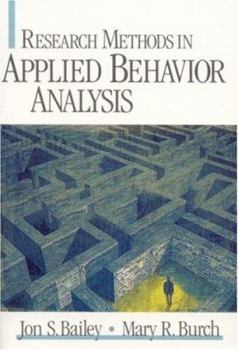Research Methods in Applied Behavior Analysis
Select Format
Select Condition 
Book Overview
This very practical, how-to text provides the beginning researcher with the basics of applied behavior analysis research methods. In 10 logical steps, this text covers all of the elements of single-subject research design and it provides practical information for designing, implementing, and evaluating studies. Using a pocketbook format, the authors provide novice researcher with a "steps-for-success" approach that is brief, to-the-point, and clearly delineated.
Format:Paperback
Language:English
ISBN:0761925562
ISBN13:9780761925569
Release Date:February 2002
Publisher:Sage Publications, Inc
Length:280 Pages
Weight:0.87 lbs.
Dimensions:0.6" x 6.1" x 9.1"
Customer Reviews
3 ratings
Finally, a text that teaches behavior analytic research skills behavior analytically!
Published by Thriftbooks.com User , 14 years ago
I found Bailey & Burch's outstanding text by happy accident, while searching for a resource for my BCBA students, who are preparing posters to present at the end of their practicum course. It was so perfect for them that I sent the publication information to them -- with an apology that it came too late for their course on research methods in applied behavior analysis! Bailey and Burch get the pedagogy for this text RIGHT -- that is to say, they teach like the behavior analysts they are. Behavior analysts are those helping and teaching professionals who, by dint of their research and practical experience, really should "know better" than to confuse "telling" with "teaching." In consultation to teachers and caregivers, behavior analysts have repeatedly demonstrated that effective instruction is based on task-analysis followed by practice and feedback on those tasks. Unfortunately, up to now, there was no text on research methods that went beyond a "train and hope" orientation. Previous texts adroitly described the types of research designs available and accurately explained the means by which to evaluate graphic displays of data; this provided the "training." Beyond that, though, students had to "hope" that a willing mentor assisted with the rest. Instructors, too, had to "hope" that, after the coursework was finished, the students were ready to apply what they and the text had taught (presumably through contingency adduction and selection through consequences). Bailey and Burch do something completely different: they provide what was previously left to "hope;" the text progresses from the task analysis components involved, from picking a topic of study, through gaining access to a research site, to currying favor with the persons found there, in preparing a successful HS-IRB application, all the way through manuscript preparation and publication. This is what it means to teach behavior analysis behavior analytically.
Easy to read
Published by Thriftbooks.com User , 18 years ago
This book is easy to read, has useful information, and the author has a good sense of humor.
Splendid guide to quality research
Published by Thriftbooks.com User , 22 years ago
Up-to-date guide to developing worthwhile research projects in applied behaviour analysis. Well-written and stimulating style. Will be an essential read for students who are aiming for Behavior Analyst Certification Board credentials and for professionals who aspire to publishing high quality research in top-rated research journals. I will certainly be recommending it to graduates and advanced undergraduates who choose to conduct applied projects as part of their studies.There are several other books on the topic available. Many are useful, even if up to 20 years in print, and should be read too as they contain different details. However this book updates recommendations and includes recent developments in electronic literature research, data-collection, and presentation.A distinctive aspect of Bailey & Burch (2002) is that it acknowledges the difficulties of conducting good behaviour analytic research and suggests how to avoid those difficulties (e.g., conducting informal pilot studies) or how to escape them if they do arise (e.g., recognising when a service is just not a suitable host for the fledgling researcher). These considerations are not usually included in research methods texts. It is refreshing and inspiring that the authors are making public their research development "secrets for success".The authors recommend extremely high standards for evaluating the quality of data. Even some well-established highly published research groups may not meet those standards. Students may need help in recognising where compromises are acceptable to enable them to conduct reserach that is practically possible and still valid.Overall - this book is splendid.





